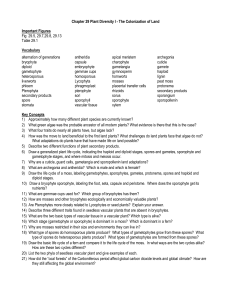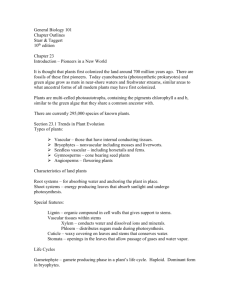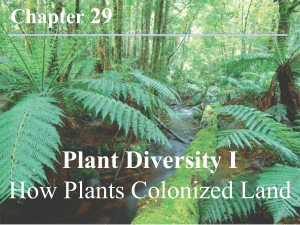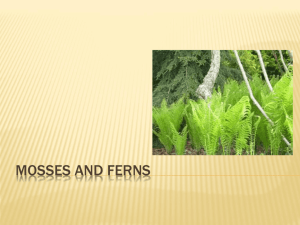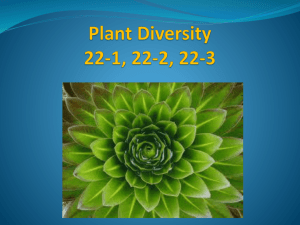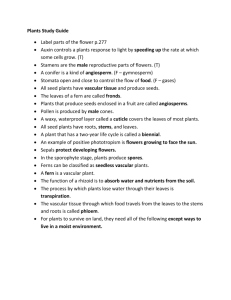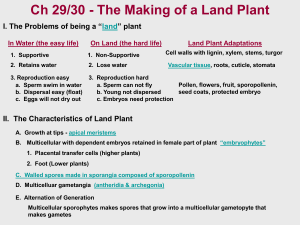(Chastain) for Organismal saved on 25feb09
advertisement
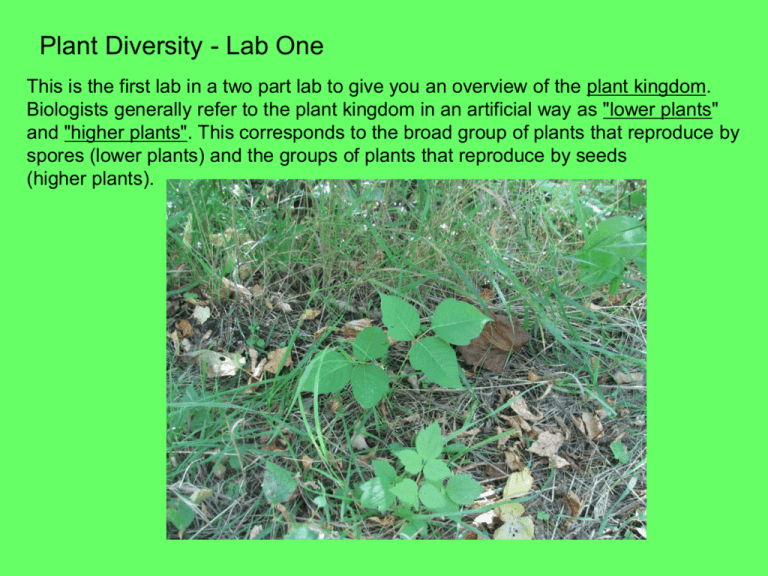
Plant Diversity - Lab One This is the first lab in a two part lab to give you an overview of the plant kingdom. Biologists generally refer to the plant kingdom in an artificial way as "lower plants" and "higher plants". This corresponds to the broad group of plants that reproduce by spores (lower plants) and the groups of plants that reproduce by seeds (higher plants). The term "lower plants" or "higher plants" also refers when these groups of plants first evolved, with lower plants representing the ancient plant groups and higher plants representing the modern plant groups. Where did terrestrial plants come from?........ Around 500 million years ago, the interconnected land masses of the planet were unoccupied by plants (or animals). Then, sometime around 450 million years ago, plants first emerged from bodies of freshwater such as lakes and ponds, to form the group of plants we refer to as the Bryophytes. These are the mosses and liverworts. DNA evidence points to the group of fresh water green algae, the Charophytes, as the ancestors to bryophytes and thus all plants that dwell on land. Hence, all land plants living today, from the tiny duckweed to the mighty redwood have as their great, great, great, grandmother,a single species of Chara. Chara is also called pondweed and can be easily found in local lakes. Chara (stonewort) .....the ancestor group to terrestrial plants....found in local lakes Bryophytes are represented by several distinct groups, including the mosses and liverworts. Moss Liverwort As the first plants to emerge from the water and inhabit the terrestrial biosphere, they are very primitive in structure. They resemble their alga ancestor in many ways such as reproducing via spores and not seeds. It will take the plant kingdom some 150 million years to evolve the kind of structures and seed reproduction that modern plants now have Liverwort growing on soil at seep bog (MSUM Science Center) Clump of moss. Inset: two different moss species The next group of plants to evolve after the Bryophytes are referred to collectively as the "seedless vascular plants" They are a diverse group that dominated the earths flora circa 350-250 million years ago. In essence, these were the first true land plants since they evolved the kind of "equipment" required to to occupy dry ground, namely, roots and a vascular system. Living representatives include: Ferns Clubmosses Horsetails I. Bryophytes - Greek for moss As plants with similar evolutionary rank, mosses and liverworts share many characteristics with regard to structure and reproduction, although they appear quite different from one another Liverwort is named for its lobed thallus that resembles a human liver Thallus - Botanical term for the body of the plant Moss Since they represent the first plants to colonize the land, bryophytes are considered the most primitive of all terrestrial plants.........here's why: (i) they lack roots.....instead they have tiny single-celled hair like rhizoids that grow from the underside of the plant into the soil. Liverwort thallus cross section Rhizoids cannot function as roots since they are only a single cell QuickTi me™ and a TIFF (Uncompressed) decompressor are needed to see this picture. soil Instead, the rhizoid functions to anchor the plant to the ground to keep it from washing away in a rain storm (ii) they lack a vascular system - these are the xylem and phloem pipes that serve to transport water and minerals (xylem) and sugars (phloem) throughout the plant body (iii) they reproduce by spores and not seeds: these are single-celled reproductive cells that are released to the wind to establish a new plant moss spores from a spore capsule Because of these primitive qualities, we should really consider these plants as the "beach head" of the plant kingdom, rather than true terrestrial plants. ...without roots and a vascular system, these plants are incapable of dwelling on dry ground. They require more or less permanent wet ground, and must grow close to the ground so as to absorb water with their entire body like a sponge. QuickTime™ and a TIFF (LZW) decompressor are needed to see this picture. I. Seedless Vascular Plants For lack of a better name, this group is referred by botanists as the seedless vascular plants. Not highly related to each other, except by evolutionary status, these plants legitimately can be thought of as the first true land plants. In there hey-day, they formed a vast and luxuriant green landscape consisting of dense forests of now extinct 60 foot tall tree species of horsetails, clubmosses, and ferns. Today, they make up only a small fraction of the earths flora since they were unable to compete with seed plants that evolved later. scene from when the seedless vascular plants ruled the world QuickTime™ and a TIFF (LZW) decompressor are needed to see this picture. Dragon fly with 2 ft wingspan! Ferns are the most familiar members to us and are the most widespread in today's landscape Their mode of reproduction is typical of all primitive, spore bearing plants in how they utilize a distinct "alternation-of-generation" method of sexual reproduction. Alternation-of-generations: All plants, unlike animals, are actually comprised of two organisms. One is called the gametophyte plant and the other the sporophyte plant. How this most radically differs to how animals reproduce is that plants include a reproductive cell called a spore, in addition to the other two kinds of reproductive cells, sperm and egg during sexual reproduction. The fern alternation-of-generation method of sexual reproduction The function of the sporophyte plant is to produce spores....spores then germinate and grow into the gametophyte plant. The function of the gametophyte plant is to produce the gametes, either egg (function of the female gaemtophyte plant) or sperm (the function of the male gametophyte plant). Compare the fern sporophyte plant to its gametophyte plants: sperm bearing structures rhizoids rhizoids egg bearing structures female gametophyte ......actual size ~1/2 inch male gametophyte ....actual size ~1/4 inch sporophyte ........actual size ~ 1.5 ft The plants in this group vary in how and where the sporophyte plant bears the spores: Ferns bear spores underneath their leaves in structures called sori (singular= sorus) Rows of sori on fern frond a single sorus with clusters of sporangia Clubmosses and Horsetails bear their spores in primitive cones called strobili (singular = strobilus) QuickTi me™ and a TIFF (LZW) decompressor are needed to see this picture. The scales of the cone that bear the spores are called sporophylls Horsetail strobilus The End
